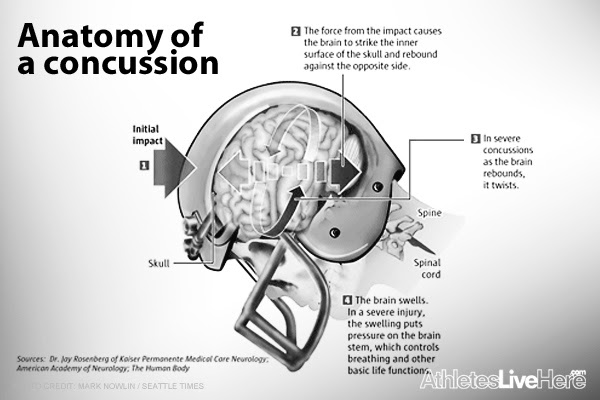Concussion Concerns
Concussions occur when a player is hit in the head, neck, face or any part of the body that causes sudden rapid head movement. This causes the brain to be jostled around inside the skull. It is a brain injury.
Symptoms include the player being dazed, having difficulty walking from the field, and changes in behavior, emotions, or thinking. Having multiple concussions over years of playing football can lead to Chronic Traumatic Encephalopathy (CTE).
CTE is brain degeneration thought to be caused by repeated head trauma. The symptoms begin years after the trauma occurs and manifest as memory loss, changes in personality, and emotional instability often leading to suicide.
It has been seen in professional football players, boxers, ice hockey players and others who participate in contact sports. It is thought to also be found in some military personnel who have been in war zones and exposed to explosive blasts that cause head trauma.
Unfortunately, CTE can only be diagnosed by studying the brain after death to look at changes in the brain tissue itself. Numerous sports figures who have had many or severe concussions have already decided to donate their brains for study after they die.
There is still a lot the experts do not understand about this disorder. This is why there are such strict protocols and rules surrounding concussions in college football.

A player who suffers a concussion must be removed immediately from play and evaluated by someone trained in concussion protocols. The player may show any of the following symptoms when evaluated:
• Appears dazed or stunned.
• Is confused about assignment or position.
• Forgets plays.
• Is unsure of game, score or opponent.
• Moves clumsily.
• Answers questions slowly.
• Loses consciousness (even briefly).
• Shows behavior or personality changes.
• Confusion.
• Can’t recall events after hit or fall.
Players often report the following symptoms:
• Headache or “pressure” in head.
• Balance problems or dizziness.
• Nausea or vomiting.
• Double or blurry vision.
• Sensitivity to light
• Sensitivity to noise.
• Feeling sluggish, hazy, foggy or groggy.
• Does not “feel right”
• Concentration or memory problem
If a
concussion is suspected in a player after evaluation, the following steps are
taken:
1.Remove the student-athlete from play. Do not allow the player to “shake it off” and go back onto the field. This is particularly hard when the player is the star quarterback or pass receiver and it is a close game or a very important game.
2. Ensure that the student-athlete is evaluated right away by an appropriate health care professional. The player should be assessed for signs and symptoms of concussion by a certified athletic trainer, team physician or health professional who is experienced in concussion evaluation and management.
3. Allow the student-athlete to return to play only with permission from a health care professional with experience in evaluating for concussion. The appropriate time to return to play should be determined by athletics medical staff, not the player or coach.
4. Develop a game plan. Each player in a concussion protocol should have an individual, step-by-step plan with gradual increases in physical exertion and risk of contact. Each institute (school) has its own concussion protocol, which should be followed closely.
As more research is being done, treatment has trended to a more conservative approach with time before returning to play longer to ensure that the brain has completely healed. A second concussion before healing has occurred can cause even more damage to the brain.
For more information on concussions and their treatment please refer to “NCAA Sports Medicine Handbook Guideline on Concussions” or on line at www.NCAA.org/health-safety and www.CDC.gov/Concussion.